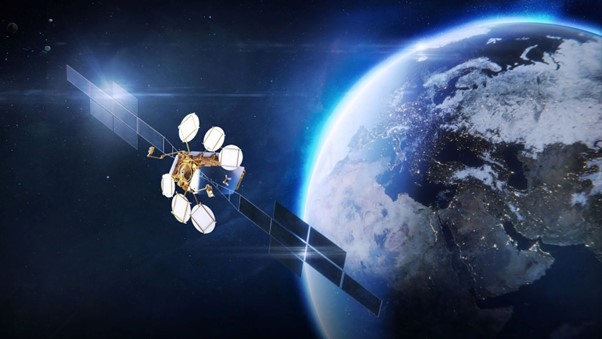Saturation affects high-throughput satellite bus, HTS high-speed internet access guide, Frequency reuse technology
How Saturation Affects High-Throughput Satellite Bus
Aug 3, 2022
High Throughput Satellites buses (HTS) are a satellites that primarily provides high-speed internet access. HTS employs frequency reuse technology, which allows the spacecraft to serve more people, often more than twice as many as current communication satellites. As a result, the cost per bit is lowered. HTS also gives internet access to rural places where a terrestrial connection is not available.
In HTS buses, the tendency is toward smaller beams and higher throughputs. These platforms are designed for high data rates, employing several spot beams with considerable frequency reuse to achieve more capacity than traditional satellite buses for broadcast purposes.
However, research shows that measurement variance increases by 18% due to bus saturation, which can be a challenge for this breakthrough technology. In this article, we will discuss how saturation affects a satellite bus.
How Saturation Affects High-Throughput Satellite Bus – HTS Advice
How Does Satellite Bus Work?
Before we dig into what HTS systems are and what saturation is, we must understand specific satellite bus details. A satellite bus refers to the architectural body and core system of a spacecraft — and is used to convey a satellite payload like a regular city bus transports its passengers. In layman’s terms, it’s a core or critical data or energy distribution network within a satellite. The transmission of data, telemetry, or satellite bus power makes the spacecraft operational.
Even though each satellite payload is unique, all such elements are constructed similarly. The satellite bus comprises various subsystems, each having its own purpose. For instance, the communication subsystem includes parts like receivers and transmitters that allow the satellite to connect with operators on Earth. Several satellite activities are governed by software orders delivered from Earth through radio transmissions.
There are many uses for these buses. They can be used for lowering satellite design prices, and it also helps in increasing payload durability through repeating payload as well as system testing. Moreover, it aids in increasing production to two times while retaining a manufacturer’s guarantee for the duration of production and, lastly, improving the service life of satellites in orbit.
How Do HTS Systems Work?
HTS systems are communications systems that can give higher throughput than traditional fixed, broadcast, and mobile satellite services. The utilization of numerous ‘spot beams’ to span a specific service area instead of large beams is the one essential change in the structure of an HTS network, which provides a two-fold advantage:
- Higher transmit/receive gain: Thanks to the higher directivity and thus higher gain, a relatively narrow beam produces more power, allowing the use of smaller access points as well as the use of higher-order modulations, resulting in higher data transmission rate per orbital spectrum unit.
- Frequency reuse: When numerous spot beams span the same service region, several beams may reuse the same frequency range and polarization, enhancing the system’s ability.
HTS systems can deliver 20 times the total throughput of a traditional FSS satellite. This achievement drastically decreases the cost per bit, eradicating the end-user perception that satellites are “too costly,” an old idea that has hung over the sector for too long. Undoubtedly, the satellite sector is experiencing a period of rapid growth.
However, this accomplishment has not been without its difficulties. To begin, the architecture of HTS necessitates more complicated infrastructure. The intricacy of satellite buses is growing due to increased processing needs for space missions.
There are numerous ways to address failure detection and recovery in the development of communication networks. In distributed communication systems, four types of failures may be detected. These include data corruption, synchronization loss, channel disconnection, and channel saturation. In the next section, we will see what causes saturation.
What Is Saturation, and How Does It Impact?
Saturation is a communication channel’s ability to handle incoming messages over its specified capacity. In simple words, it is caused by data overload in satellite communications. The saturation can be assessed by tracking the bus utilization (BU). The BU is directly connected to the number of incoming communications, the communication system implementation characteristics, as well as the size of the network.
The bus utilization is the ratio of the time it takes to send a cluster of messages divided by the available time on the satellite bus to fulfill this operation during each transmission cycle. The BU analysis necessitates keeping track of the overall amount of messages sent over the communications network in every synchronization event.
However, the saturation effect can result in propagation delay. Research shows that measurement variance increases by 18% due to bus saturation. Overloading of data leads to inaccurate measurements. Delays in data transmission cause problems in satellite operation, such as under- or over-actuation in spacecraft movements. It could also reduce controller stability margins, resulting in unfavorable operating situations.
To reduce channel saturation, three operational factors are often regulated: the channel synchronization time, data rate, and buffer size of the channel. It is also vital to choose a communication system that has demonstrated excellent durability in severe conditions for implementation purposes.
Final Thoughts
It is no doubt that satellites are an indispensable technology that has helped mankind in innumerable ways. However, challenges along the way are inevitable. HTS systems greatly aid a space mission and reshape the space technology sector. But, saturation can hinder data propagation. Hence, it becomes crucial to control the saturation of communication channels to reduce data delay.
Let us know your thoughts on this in the comment section below.
Comments on this Saturation Affects High-Throughput Satellite Bus article are welcome.
Home Design Articles
Top 5 best TV corner wall mounts
14 Common Kitchen Design Mistakes to Avoid
How to design a kitchen: 10 essential design steps
What style of kitchen is perfect for your home
Building Articles
Comments / photos for the How Saturation Affects High-Throughput Satellite Bus page welcome







